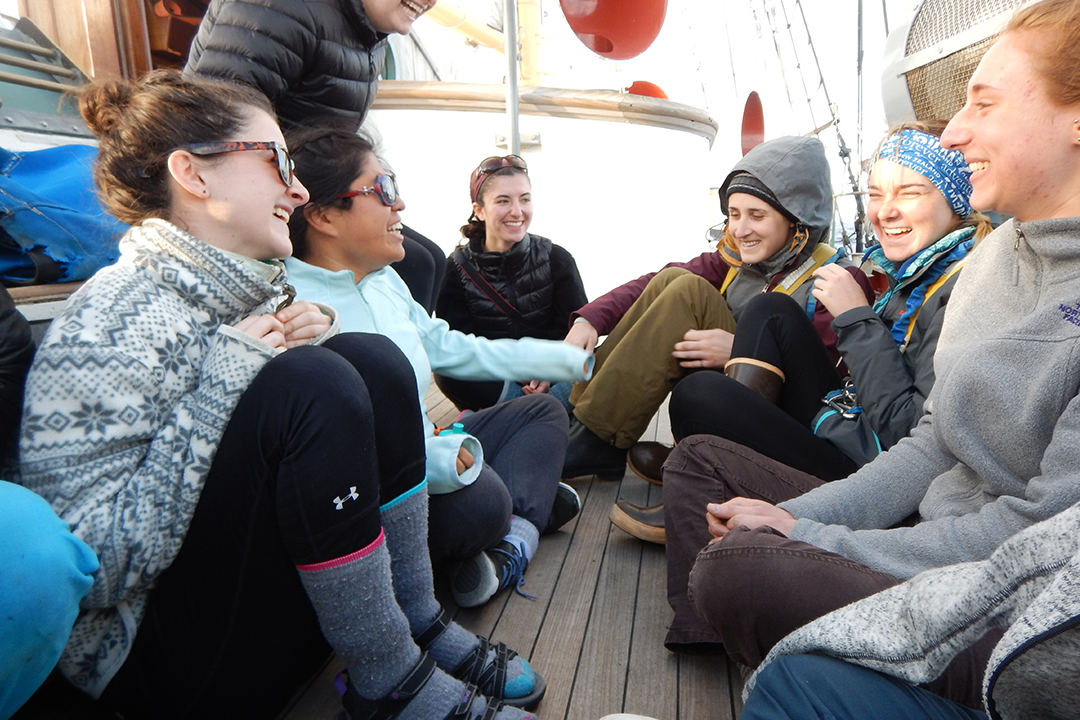At latitude 42 degrees South, longitude 165 degrees West—somewhere in the middle of the South Pacific Ocean, roughly 200 nautical miles east of New Zealand—Lily Anna Segalman got her sea legs. An environmental studies major, Segalman held steady to the rail of the tall ship—a 135-foot Brigantine named the Robert C. Seamans—as 20 foot swells sprayed her head to toe with salt water. For the first time since setting sail 10 days earlier, she stumbled across the wooden deck in 25 knot winds without getting seasick.
“I considered that a major victory,” she laughed. “I wouldn’t say I was a sailor yet. But it was a start.”
Lily Anna Segalman navigates with a sextant. (Photo courtesy: Lily Anna Segalman)
Segalman was in the midst of a 12-week journey at sea. Along with 13 other students from 12 different schools—including Turi Abbott, an international affairs major and environmental studies minor—she enlisted in the Sea Education Association’s SEA Semester, a study abroad program that combines oceanography research with basic seamanship. Segalman, a rising senior, and her shipmates spent 37 days aboard the Robert C. Seamans on a 3,900-mile voyage through French Polynesia—virtually of all it without seeing land or another ship—before dropping anchor in Tahiti. Along the way, they conducted hands-on environmental research into the man-made dangers facing the ocean and sea life. And, by the end of their trip, Segalman, a professed landlubber, could stitch sails, tack through the wind and navigate the open ocean by charting the stars.
“When I set foot on the boat, I didn’t know the difference between port and starboard,” she said. “When we finally made land, I couldn’t wait to get back out to sea.”
Since 1971, SEA Semester has hosted more than 8,000 students traveling over a million miles on maritime missions. Students conduct scientific research on threats to the health and sustainability of the world’s oceans—such as climate change, marine pollution, habitat loss and overfishing—while also learning all the duties of a ship’s crew.
Neither Segalman nor Abbott had much sea experience, but both had a passion for environmental studies. At GW, Segalman worked with Assistant Professor of Biology Keryn Gedan on measuring the impact of rising sea levels on the Chesapeake Bay tidal marshes. SEA Semester gave her the opportunity to use the entire South Pacific as her lab.
“I thought this was a once-in-lifetime experience to do what really only oceanographers get to do,” Segalman said, noting that, while the ocean covers three-quarters of the earth, 90 percent remains largely unexplored. "I thought the best way to learn what was going on out there was to see it first-hand.”
After a training and study program at SEA’s oceanographic research center in Woods Hole, Mass., the crew set sail. The first leg of the journey focused on turning student-scientists into sailors. In addition to taking classes from faculty on board, the students worked rotating shifts—six hours on watch, 12 hours off—maintaining all aspects of the boat. They monitored the gusty winds that swirled through the Pacific in the wake of Cyclone Debbie. They manned the engine room, towed tuna nets and took turns standing lookout from the ship’s bow.
With only a thin curtain to shut off their bunks, privacy on the boat was as rare as the infrequent hot showers. Still, Segalman and Abbott say they hardly missed the comforts of home. After a long day of rigging sails with callused hands, they met on deck each evening and watched the sun sink below the Pacific horizon. They marveled at the diversity of marine life surrounding the boat, from dolphins swimming among bioluminescent plankton to pyrosomes, inch-long organisms that that glow through the water in giant tubular colonies.
“We were with the same 14 people in close quarters for all that time and rather than getting tired of each other, we just drew closer,” Abbott said. “I know I will be friends with these people for the rest of my life.”
For her research project, Segalman tested the ocean water for evidence of micro-plastics—remnants of which were found in virtually every sample. “It’s astounding that we found so much plastic—essentially a huge trash heap—in the middle of the South Pacific,” she said. Her findings point to the density of plastic polluting the world’s oceans and the sheer volume of industrial chemicals that find their way to even the most remote corners of the world. “There’s not much out here. There aren’t many other humans or vessels or development. That means this plastic is traveling throughout the entire ocean to get here.”
The Robert C. Seamans, a 135-foot Brigantine ship on the South Pacific Ocean. (Photo courtesy: Turi Abbott)
In early May, the crew made landfall in Pape'ete, Tahiti. At first, the ground felt unsteady to Segalman. The rush of sensations—from dodging pedestrians on sidewalks to stomaching the mulch-like smell of fresh dirt—were as overwhelming as the saltwater waves weeks before. “When you’ve been off-land for so long, it’s hard to manage all of the sights and smells and movements that suddenly rush at you,” Abbott said.
Segalman isn’t ready to trade in her lab coat for a scuba suit yet—although she jokingly wonders whether the GW Sailing Team has room for a scientist who can chart their global positioning with sextants and celestial bodies. She’s spending the summer on dry land, continuing her Chesapeake Bay research with her professor. Still, she said, she misses waking up to an alarm clock rather than a Pacific sunrise. “I took a lot of memories and experiences off that boat that will stay with me for a lifetime—whether that’s a lifetime on land or at sea,” she said.




